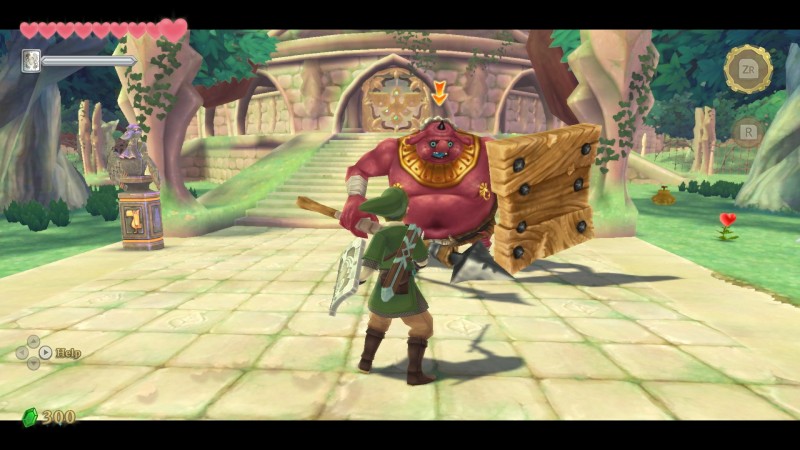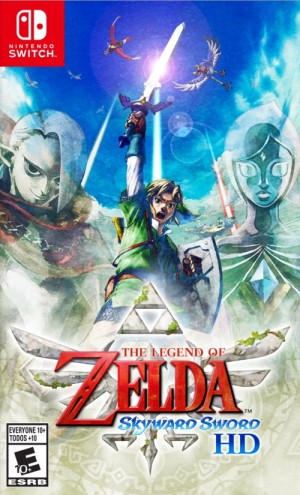 Click to watch embedded media
Click to watch embedded media
Skyward Sword was never my favorite Zelda game. Nintendo’s Wii-era take on its beloved franchise introduced motion controls that left me both flustered and annoyed during combat. At the same time, Skyward Sword’s dungeon and boss design remain some of the best the series has to offer. Skyward Sword HD revives this divisive game and papers over some of the original's biggest flaws. One of the most notable additions is a new button-only control scheme that allows players to experience the game without flailing their arms. Unfortunately, Skyward Sword’s overall structure remains largely the same, and its abundance of fetch quests means that this is still a game of dramatic peaks and valleys.
I’ll cut right to the chase: Skyward Sword HD’s new controller inputs are a step up from the original motion controls. Player’s looking to relive the Wii’s glory days can stick with the old control scheme and use their Switch Joy-Cons to swing Link’s sword or aim his bow, and these motion controls work about as well as they did on the Wii – meaning they work about 85 percent of the time. I love the authenticity of swinging a remote and watching Link replicate my attack onscreen, but he too often slices instead of stabs, which can spell the difference between gaining the upper hand in combat or missing the enemy and taking a hit. These motion controls always seemed like a novelty anyway, so I'm glad Skyward Sword HD’s button-only controls provide an alternative, using the right analog stick to replicate your sword's movements. These analog stick attacks are more consistent but still aren't as precise as the traditional button-based input found in other Zelda games. This system is also unintuitive; even a few dozen hours into the game I felt unnatural jiggling the right stick at every approaching enemy. Fortunately, you don't have to be precise, and most enemies eventually fall if you persistently spam your attacks.
Click image thumbnails to view larger version

In addition to the new control scheme, Skyward Sword HD has several other welcome changes. You can now fast forward through dialogue and skip cutscenes altogether, which makes the story feel a little less plodding and allows you to blast through the chatter during a replay. The original release bombarded you with item descriptions, offering details on everything you picked up each time you started the game. Skyward Sword HD fixes that strange quirk and only makes you read item descriptions once. Finally, Amiibo support means you can fast travel at any time and your companion, Fi, now offers helpful advice at the press of a button to keep you from getting lost or stuck, which is something I wish I had 10 years ago.
All of Skyward Sword HD’s small changes add up, but they don’t fix the original's larger design issues. Skyward Sword's overworld is massive but largely empty, and the main quest is incredibly linear, which left me less excited to explore off the beaten path. Still, Skyward Sword’s biggest design flaw is its series of fetch quests you're forced to complete in each area. For example, before entering the first dungeon, you have to hunt down a group of anxious bird-like creatures who stick their head in the ground, masquerading as bushes. Later on, before entering a mining facility, you have to find a handful of broken generators. These quests feel like unnecessary padding, are full of mindless backtracking, and don’t add anything meaningful to the narrative or your adventure. In fact, the only thing they add meaningfully to is your play clock.
Click here to watch embedded mediaIt’s a shame the journey to Skyward Sword’s dungeons is so much work because the dungeons themselves are a highwater mark for the series. During Link’s journey, you travel through a skeleton-infested cavern, a sand-trapped pirate ship, and an ancient temple buried in the heart of a volcano. The puzzles in each dungeon feel fresh even today, and each labyrinth invites you to use your ever-expanding toolset in inventive ways. Whether I was riding over rivers of lava on a giant boulder, using time stones to shift between eras, or swinging over vine-covered caverns like Indiana Jones, I consistently felt like I was on some wild adventure.
In some ways, Skyward Sword was the end of an era. It follows the pattern Nintendo established back in 1998 with The Legend of Zelda: Ocarina of Time, and it was the last game in the series before Nintendo reconceived the series with Breath of the Wild. In some ways, Skyward Sword perfects Ocarina's template, but that formula also feels well-worn and stuffed with unnecessary junk. Despite all the ways Nintendo updated this package, Skyward Sword remains far from my favorite entry in the series, but this is clearly the best way to play this blemished gem.

Score: 8
Summary: Skyward Sword’s overall structure remains largely the same, and its abundance of fetch quests means that this is still a game of dramatic peaks and valleys.
Concept: Zelda’s infamous Wii entry returns, but now players can flip between motion controls and button-only inputs
Graphics: These 10-year-old graphics hold up surprisingly well thanks to solid art design and an HD upgrade
Sound: The orchestrated music is beautiful and nuanced, but the limited grunts from NPCs feel goofy and outdated
Playability: A handful of quality-of-life improvements – including the ability to use controller inputs – makes this a much smoother experience
Entertainment: Skyward Sword has some of the best dungeon design in the series, but the sections between each dungeon are a slog
Replay: Moderate
No comments:
Post a Comment